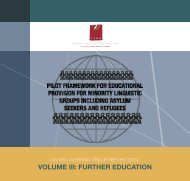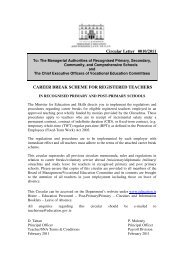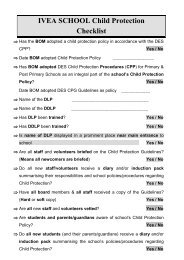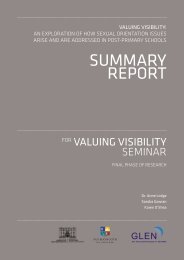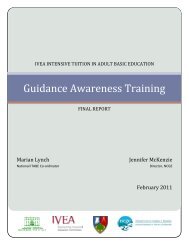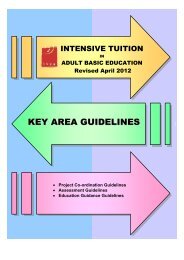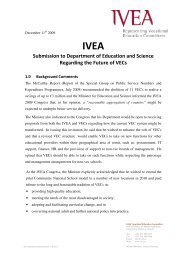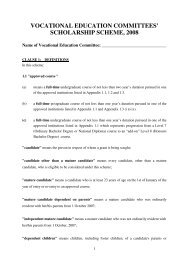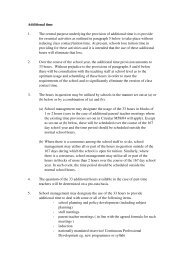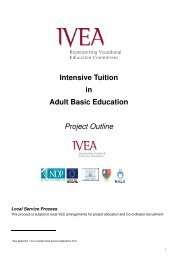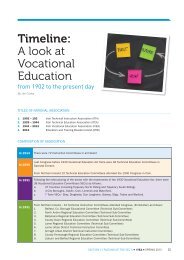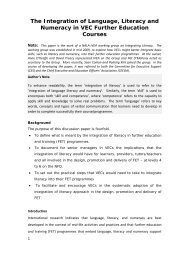Download File - IVEA
Download File - IVEA
Download File - IVEA
Create successful ePaper yourself
Turn your PDF publications into a flip-book with our unique Google optimized e-Paper software.
7<br />
ADDRESSING<br />
THE EDUCATIONAL<br />
NEEDS OF SEPARATED CHILDREN<br />
7.1 INTRODUCTION<br />
Unaccompanied minors are asylum seeking children and young<br />
people under the age of eighteen (18) who are separated from their<br />
parents/legal caregivers 76 . Recognised in Irish domestic legislation,<br />
this term has been critiqued for not adequately describing the<br />
situation of these children. The Separated Children in Europe<br />
Programme defines ‘separated children’ as:<br />
…children under 18 years of age who are outside their coy<br />
of origin and separated from both parents, or their previous<br />
legal/customary caregiver. Some children are totally alone<br />
while others…may be living with extended family members….<br />
Separated children may be seeking asylum because of fear of<br />
persecution or the lack of protection due to human rights<br />
violations, armed conflict and disturbances in their own<br />
country. They may be victims of trafficking for sexual<br />
exploitation or other exploitation, or they may have travelled<br />
to Europe to escape conditions of serious deprivation 77 .<br />
Separated children flee to Europe for many reasons. Parents and<br />
family members may have been killed or imprisoned. 78 During war<br />
and conflict, separated children are sometimes sent abroad for their<br />
own safety and to avoid conscription. When separated children<br />
flee poverty, they can be expected to send remittances to family<br />
members in home countries. Placing a huge burden upon separated<br />
children, deportation and migration failure results in enormous<br />
financial costs for home communities.<br />
Reflecting patterns in adult statistics, the number of separated<br />
children arriving in Ireland has risen substantially. Nine separated<br />
children applied for asylum in 1997, with these statistics raising<br />
considerably to 300 in 2000 and 425 in 2001. Statistics on referrals<br />
of separated refugee children to the Health Board indicates much<br />
higher numbers. For example, 505 separated children were recorded<br />
in 2000 and this figure rose to 825 in 2002. However, these<br />
statistics include children who arrived alone in Ireland and who were<br />
subsequently reunified with family members, together abandoned<br />
with children of asylum seekers/refugees currently living in Ireland.<br />
600<br />
500<br />
400<br />
300<br />
200<br />
100<br />
0<br />
9 20<br />
34<br />
300<br />
425<br />
500<br />
1997 1998 1999 2000 2001 2002<br />
Figure 1: Number of separated children to apply for asylum 1997-2002<br />
Source: Department of Justice, Equality and Law Reform<br />
Year<br />
2000<br />
2001<br />
2002<br />
Number<br />
505<br />
730<br />
877<br />
Table 1: Number of separated children referred to the Team for Separated<br />
Children Seeking Asylum 2000 - 2002.<br />
Source: Northern Area Health Board and The Social Work Team for<br />
Separated Children<br />
32<br />
76<br />
UNHCR Refugee Children: Guidelines on Protection and Care, UNHCR: Geneva: 1993.<br />
77<br />
Separated Children in Europe Programme Statement of Good Practice Save the Children/UNHCR, Brussels: 1999, Section 2.1.<br />
78<br />
Rutter, J. Supporting Refugee Children in 21st Century Britain: A Compendium of Essential Information, Trentham Books, London: 2001.



